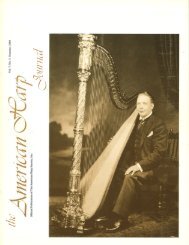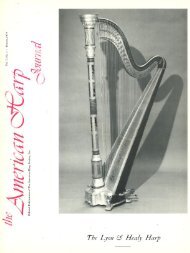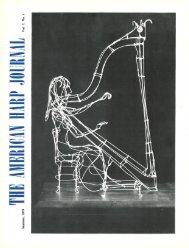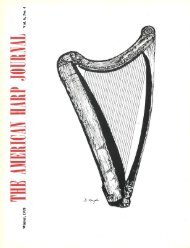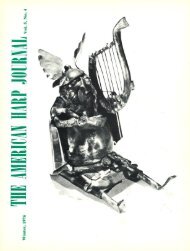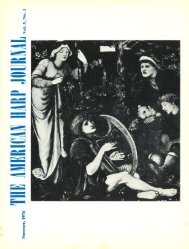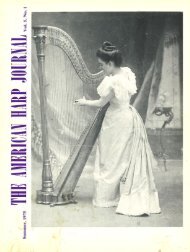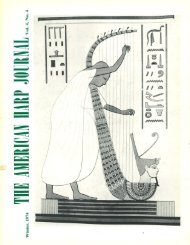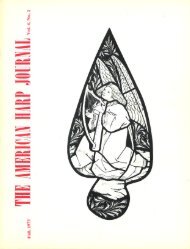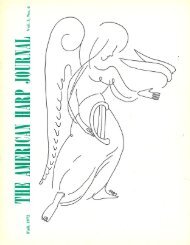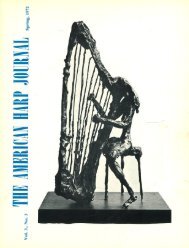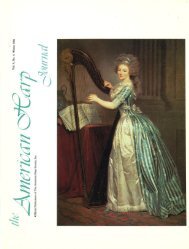You also want an ePaper? Increase the reach of your titles
YUMPU automatically turns print PDFs into web optimized ePapers that Google loves.
C.P .E. Bach's<br />
Harp Sonata<br />
by Darrell M. Berg<br />
Darrell Berg is the author of a number of studies on the<br />
keyboard works of C.P.E. Bach including her doctoral dissertation<br />
and an article recently published in the Journal of<br />
the American Musicological Society. She is presently completing<br />
a study of Bach's methods of revising his sonatas and is<br />
preparing a facsimile edition of all of his solo keyboard<br />
works for Garland Publishing, Inc. and a three-volume<br />
urtext edition of the sonatas for G. Henle Verlag in Munich.<br />
Dr. Berg was graduated from the Juilliard School of Music<br />
as a violinist and has been a member of several major<br />
orchestras including the Cincinnati Symphony Orchestra.<br />
She also holds an M.A. from Smith College and a Ph.D. in<br />
musicology from the State University of New York at Buffalo.<br />
She is Professor of Music History at the St. Louis<br />
Conservatory of Music where she teaches music history and<br />
literature and is co-director of the collegium. During the<br />
past summer she was a member of the Aston Magna<br />
Academy where she delivered lectures on musical developments<br />
in north Germany in the eighteenth century.<br />
Carl Philipp Emanuel Bach's Sonata in G Major for the<br />
Harp, Wq 139, 1 is his only composition for this instrument<br />
and one of a handful of works for the harp<br />
by respected and famous composers of the eighteenth<br />
century. 2 Five editions of Wq 139 have appeared<br />
since 1940 all of which are based on the single extant<br />
eighteenth-century source, a manuscript (S. 13287) in<br />
the library of the Brussels Conservatory. 3 The title<br />
page of the manuscript (fig. 1) attributes the work to<br />
C.P.E. Bach. In the upper left-hand comer are numberings<br />
which suggest that the manuscript has belonged<br />
to more than one collection. There is no date<br />
anywhere on the manuscript and no clue as to why or<br />
for whom the sonata was composed. The manuscript,<br />
moreover, is not in C.P.E. Bach's hand, and questions<br />
have been raised about the authenticity of the<br />
sonata. Lack of knowledge about eighteenth-century<br />
compos1t1ons is not unusual, but we need not be<br />
content, in the case of the harp sonata, with such<br />
doubts and scanty information. We can prove<br />
Emanuel Bach's authorship and the year of composition<br />
beyond any doubt. We shall also look at the<br />
ambience in which the harp sonata originated and<br />
entertain some conjectures about the circumstances<br />
of its origin. And since most of Bach's music has<br />
survived, we shall consider the Sonata for Harp in<br />
relation to his other works. 4<br />
<strong>Winter</strong>/<strong>1980</strong><br />
C.P.E. Bach (1714-1788) was not only a distinguished<br />
composer, but a keen businessman who kept<br />
meticulous records. On manuscripts of some compositions<br />
he entered the year of origin (and, occasionally,<br />
the year of revision); to most of his instrumental<br />
works he assigned numbers which indicate a sequence<br />
of composition. He was tireless in his efforts<br />
to control the distribution of his works and to prevent<br />
circulation of unauthorized materials bearing his<br />
name. Letters from Bach in Hamburg to out-of-town<br />
buyers reflect his passion for keeping accounts and<br />
his relish for shrewd business deals. Bach's mercenary<br />
ways, in fact, have frequently been deplored by<br />
historians. But his writings also reveal another facet<br />
of his personality. He was a collector. He took pleasure<br />
in amassing information for its own sake and for<br />
the sake of posterity; he kept an archive of music by<br />
many generations of Bachs, and he acquired a portrait<br />
collection of famous musicians from Pythagoras to<br />
Haydn.<br />
Towards the end of C.P.E. Bach's life, probably in<br />
the mid-1780's, Johann Joachim Heinrich Westphal,<br />
an organist in Schwerin who was an admirer of Bach,<br />
began to collect his works and to correspond with<br />
him. The two musicians recognized kindred spirits in<br />
each other, and an enthusiastic exchange of musical<br />
materials and portraits ensued. From the activities of<br />
these collectors came two extremely valuable thematic<br />
catalogues of C.P.E. Bach's works. In 1790, little<br />
more than a year after Bach's death (December 14,<br />
1788), his widow, Johanna Maria, published a<br />
NachlajJ Verzeichnis-a catalogue of his musical estate.<br />
5 We know that some parts of the NachlajJ<br />
Verzeichnis had been completed by Emanuel Bach in<br />
the last years of his life, and it is very likely that the<br />
entire catalogue was prearranged by him. The<br />
NachlajJ Verzeichnis purports to list all works which<br />
Bach acknowledged as his own and copies of which<br />
(according to a note on its title page) could be purchased<br />
from his widow in Hamburg. Dates and places<br />
of composition are given for most of the instrumental<br />
works; for each work not published in Bach's<br />
lifetime, this information is followed by an incipit<br />
(the beginning notes of the initial melody) of the first<br />
movement. The Sonata for Harp is listed under Soli as<br />
"no. 18. B. lBerlin] 1762, fur die Harfe" (fig. 2), and<br />
following this entry is an incipit of the true first<br />
movement.<br />
Westphal carried on his correspondence with the<br />
Bach family after Emanuel's death, obtaining scores<br />
and information from Bach's widow and his daughter,<br />
Anna Carolina Philippina. 6 Between 1809 and<br />
1825 (the year of Westphal's death), the Schwerin<br />
organist completed a catalogue of his own collection<br />
9




